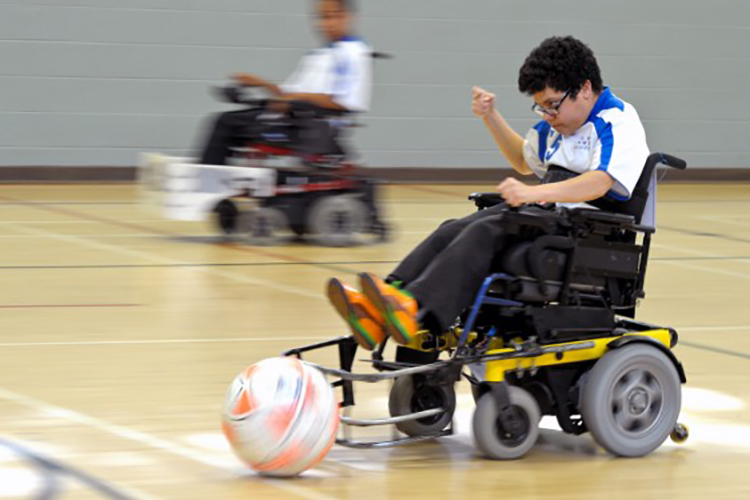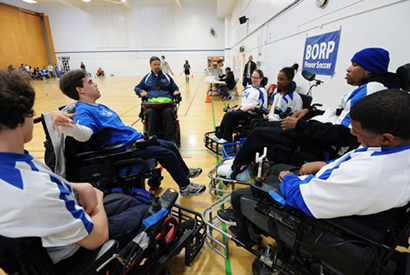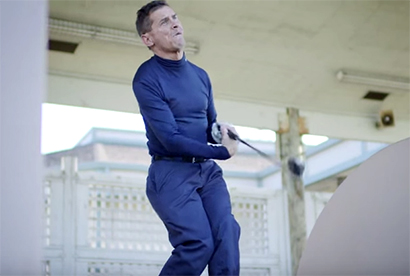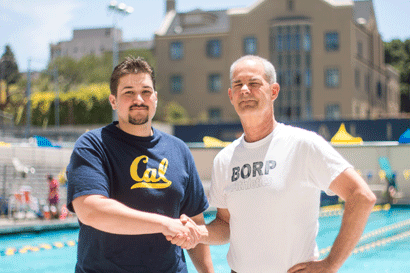Power soccer to join athletics lineup
It's the latest sport offered to Berkeley students through Athletics for All, a model program breaking down barriers for people with disabilities

August 21, 2015
First came golf, then goalball, and now power soccer is joining the sports open to Berkeley students through Athletics for All, a model program that is breaking down barriers for people with disabilities.
This fall, all three sports are part of a new class called “Engaged Scholarship Around Disability.” Designed for students with and without disabilities, the course consists of a lecture/discussion twice a week on theories about the body and disability and, on Fridays, playing either power soccer, goalball or golf.
Power soccer is played in a gym on a regulation basketball court by two teams of four players. The teams attack, defend and spin-kick a 13-inch ball in a challenging game similar to able-bodied soccer. Participants in this popular sport, developed in the early 1970s, often include people with muscular dystrophy, cerebral palsy, head trauma, stroke and spinal cord injury.

Power soccer was developed in the early 1970s and often includes people with muscular dystrophy, cerebral palsy, head trauma, stroke and spinal cord injury. (Photo by Scot Goodman)
This summer, four power wheelchairs arrived at Berkeley for power soccer, and now students without their own power chairs can join in. And that’s good news at Berkeley, where students without disabilities — including student-athletes in sports including water polo, football and soccer — have been interested in inclusive activities like goalball since it was introduced in 2012, says Berkeley Graduate School of Education student Matt Grigorieff, a co-founder of Athletics for All.
“The kinesthetic insight that students with and without disabilities gain from engaging in a sport together has shown dramatic benefits for elite athletes, general students and students with disabilities at all skill levels,” he says.
Athletics for All also is in the planning stages of adding a blind sailing class, which would be run in partnership with the Marin Sailing School Program for the Blind and Cal Recreational Sports’ UC Aquatic Center. It would teach students the fundamentals of sailing — including how to use the equipment and how and why to trim the sails — through the use of creative and adaptive methods. While sailing, able-bodied students in the class would wear blindfolds at times, to help them gain a new understanding of ability.
“Sailing actually is a really great sport for people who are blind because there is so much feel to it,” says Danette Davis, director of the Marin Sailing School program. “It’s all about the feel of the wind, your body and your boat.”

Marty Turcios, a professional golf instructor hired by the campus, is helping student golfers at all levels overcome obstacles with their swings, putts, chips and drives. (KQED photo links to video)
Meanwhile, the popular “Golf with Marty,” a drop-in class open to all students and taught by Marty Turcios, a golfer who has cerebral palsy, has expanded to an additional for-credit option in the “Education, the Student Body and Disability” course. The golf portion of the class will take place at Tilden Park Golf Course. To learn more about “Golf with Marty,” visit Berkeley News or watch this KQED video.
Beginning level goalball also is part of that course. Separate classes for intermediate and competitive level goalball classes continue. Meanwhile, the Cal goalball team, the nation’s first competitive college team for athletes with visual impairments, is embarking on a crowdfunding campaign to support the cost of participating in upcoming intercollegiate tournaments across the country. Learn more about goalball on Berkeley News.

Matt Grigorieff (left), student founder of UC Berkeley’s Athletics for All, and Rick Smith, executive director of the Bay Area Outreach and Recreation Program. (UC Berkeley photos by Kevin Nguyen)
Athletics for All, the first program of its kind at a U.S. college or university, is jointly run by Berkeley and the Bay Area Outreach and Recreation Program. It was a recipient earlier this year of a Chancellor’s Community Partnership Award, and it also received financial base support during the past school year when students overwhelmingly passed a campus “wellness referendum fee” to enhance many services for students, including health programs for those with disabilities.